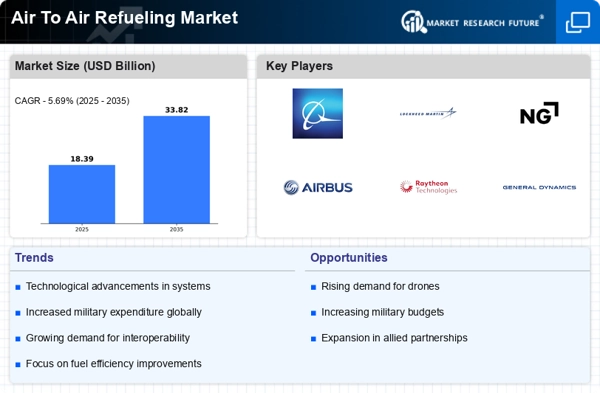Increasing Defense Budgets
The Air To Air Refueling Market is experiencing a notable surge in demand, primarily driven by increasing defense budgets across various nations. Governments are allocating more resources to enhance their military capabilities, which includes the procurement of advanced aerial refueling systems. For instance, recent reports indicate that defense spending in several countries has risen by approximately 5% annually, reflecting a commitment to modernizing air forces. This trend is likely to bolster the Air To Air Refueling Market, as nations seek to extend the operational range and endurance of their aircraft. Enhanced refueling capabilities are essential for conducting long-range missions, thereby increasing the strategic flexibility of air forces. Consequently, the growing emphasis on defense readiness and modernization is expected to propel investments in air-to-air refueling technologies.
Evolving Military Strategies
Evolving military strategies are significantly impacting the Air To Air Refueling Market. As military doctrines shift towards more agile and responsive forces, the need for effective aerial refueling solutions becomes increasingly critical. Modern warfare emphasizes rapid deployment and sustained operations, necessitating the ability to refuel aircraft in-flight. Data indicates that air forces are prioritizing the integration of refueling capabilities into their operational frameworks, which is expected to drive demand for advanced refueling systems. The Air To Air Refueling Market is likely to see growth as military planners recognize the strategic advantages of maintaining air superiority through enhanced refueling operations. This evolution in military strategy underscores the importance of investing in robust aerial refueling capabilities to support diverse mission profiles.
Strategic Partnerships and Alliances
Strategic partnerships and alliances are emerging as a key driver in the Air To Air Refueling Market. Collaborative efforts between nations and defense contractors are fostering the development of advanced refueling technologies. Joint exercises and training programs are enhancing interoperability among allied forces, which is essential for effective aerial refueling operations. Recent initiatives indicate that several countries are engaging in collaborative projects to develop next-generation refueling systems, thereby sharing costs and expertise. This trend not only strengthens military alliances but also stimulates innovation within the Air To Air Refueling Market. As nations recognize the importance of seamless refueling capabilities in joint operations, the establishment of strategic partnerships is likely to accelerate advancements in this sector.
Rising Demand for Multi-Role Aircraft
The Air To Air Refueling Market is significantly influenced by the rising demand for multi-role aircraft. These versatile platforms require efficient refueling solutions to maximize their operational capabilities. As military forces increasingly adopt multi-role fighters, the need for compatible refueling systems becomes paramount. Data suggests that the market for multi-role aircraft is projected to grow at a compound annual growth rate of around 4% over the next five years. This growth is likely to drive the demand for air-to-air refueling systems, as these aircraft often engage in diverse missions that necessitate extended flight times. The integration of advanced refueling technologies into multi-role platforms is expected to enhance mission success rates, thereby reinforcing the importance of the Air To Air Refueling Market in modern military operations.
Technological Innovations in Refueling Systems
Technological innovations are playing a crucial role in shaping the Air To Air Refueling Market. The development of advanced refueling systems, such as boom and probe-and-drogue configurations, is enhancing the efficiency and safety of aerial refueling operations. Recent advancements in automation and digital technologies are streamlining the refueling process, reducing the risk of human error. Furthermore, the introduction of lightweight materials and improved fuel transfer rates is likely to enhance the performance of refueling systems. As military operations become more complex, the demand for these innovative solutions is expected to rise. The Air To Air Refueling Market stands to benefit from these technological advancements, as they enable air forces to conduct missions with greater effectiveness and reliability.


















Leave a Comment